Animal Kingdom 1000+ MCQ with answer for LIC AAO
Thursday 9th of March 2023

Sharing is caring
1. The transition from aquatic to terrestrial lifestyles required many adaptations in the vertebrate lineage. Which of the following is not one of those adaptations ?
A. Switch from gill respiration to air-breathing lungs.
B. Improvements in water resistance of skin.
C. Alteration in mode of locomotion.
D. Development of feathers for insulation.
Answer : D
A. Switch from gill respiration to air-breathing lungs.
B. Improvements in water resistance of skin.
C. Alteration in mode of locomotion.
D. Development of feathers for insulation.
Answer : D
2. Identify the figure with its correct name and phylum.
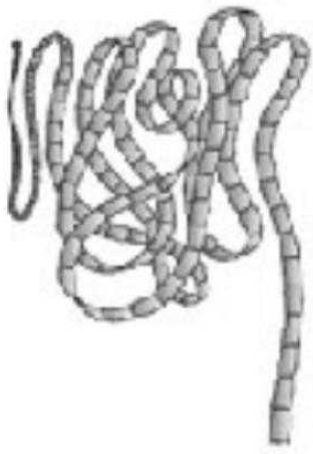
A. Sycon - Porifera
B. Aurelia - Coelenterata
C. Pleurobrachia - Ctenophora
D. Tapeworm - Platyhelminthes
Answer : D

A. Sycon - Porifera
B. Aurelia - Coelenterata
C. Pleurobrachia - Ctenophora
D. Tapeworm - Platyhelminthes
Answer : D
3. Which of the following characteristic is probably most responsible for the great diversification of insects on land ?
A. Segmentation
B. Antennae
C. Bilateral symmetry
D. Exoskeleton
Answer : D
A. Segmentation
B. Antennae
C. Bilateral symmetry
D. Exoskeleton
Answer : D
4. Which of the following class is being described by the given statements (i - iv)?
(i) They are found in a variety of habitats- polar ice-caps, deserts, mountains, forests, grasslands and dark caves.
(ii) Most unique mammalian characteristic is the presence of mammary glands by which the young ones are nourished.
(iii) Heart is four-chambered.
(iv) Sexes are separate and fertilization is internal.
A. Reptilia
B. Aves
C. Mammalia
D. Amphibia
Answer : C
(i) They are found in a variety of habitats- polar ice-caps, deserts, mountains, forests, grasslands and dark caves.
(ii) Most unique mammalian characteristic is the presence of mammary glands by which the young ones are nourished.
(iii) Heart is four-chambered.
(iv) Sexes are separate and fertilization is internal.
A. Reptilia
B. Aves
C. Mammalia
D. Amphibia
Answer : C
5. A student was given a specimen to identify on the basis of the characteristics given below.
(i) They are metamerically segmented.
(ii) Presence of closed circulatory system.
(iii) They have circular and longitudinal muscles for locomotion. Identify the specimen.
A. Prawn
B. Pheretima
C. Wuchereria
D. Ctenoplana
Answer : B
(i) They are metamerically segmented.
(ii) Presence of closed circulatory system.
(iii) They have circular and longitudinal muscles for locomotion. Identify the specimen.
A. Prawn
B. Pheretima
C. Wuchereria
D. Ctenoplana
Answer : B
6. Identify the figure with its correct name and phylum.

A. Cucumaria – Echinodermata
B. Ascidia – Urochordata
C. Balanoglossus – Hemichordata
D. Hirudinaria – Annelida
Answer : C

A. Cucumaria – Echinodermata
B. Ascidia – Urochordata
C. Balanoglossus – Hemichordata
D. Hirudinaria – Annelida
Answer : C
7. Match the features given in column I with their examples given in column II and choose the correct match from the option given below.
A. A - e, B - b, C - d, D - c, E - a
B. A - c, B - a, C - d, D - b, E - e
C. A - b, B - a, C - c, D - e, E - d
D. A - c, B - b, C - d, D - a, E - e
Answer : B
| Column-I | Column-II |
|---|---|
| (Features) | (Examples) |
| A. Pseudocoelomates | a. Hydra, Adamsia |
| B. Diploblastic | b. Ctenoplana, Aurelia |
| C. Cellular level of | c. Ascaris, Wuchereria organization |
| D. Radial symmetry | d. Sycon, Spongilla |
| E. Metamerism | e. Pheretima, Neries |
A. A - e, B - b, C - d, D - c, E - a
B. A - c, B - a, C - d, D - b, E - e
C. A - b, B - a, C - c, D - e, E - d
D. A - c, B - b, C - d, D - a, E - e
Answer : B
8. In phylum echinodermata, the adult echinoderms are ______A__________ but larvae are _______B______ .
A. A radially symmetrical; B bilaterally symmetrical
B. A bilaterally symmetrical; B radially symmetrical
C. A bilaterally symmetrical; B asymmetrical
D. A metamerically segmented; B asymmetrical
Answer : A
A. A radially symmetrical; B bilaterally symmetrical
B. A bilaterally symmetrical; B radially symmetrical
C. A bilaterally symmetrical; B asymmetrical
D. A metamerically segmented; B asymmetrical
Answer : A
9. The combination of a true coelom and repeating body segmentation allows the annelids (unlike the anatomically simpler worms) to do which of the following?
A. Attain complex body shapes and thus locomote more precisely.
B. Move through loose marine sediments.
C. Be hermaphroditic.
D. Inject paralytic poisons into their prey.
Answer : A
A. Attain complex body shapes and thus locomote more precisely.
B. Move through loose marine sediments.
C. Be hermaphroditic.
D. Inject paralytic poisons into their prey.
Answer : A
10. Which of the following statement(s) is/are correct for class amphibia?
(i) Body is divisible into head and trunk.
(ii) Respiration is through gills only.
(iii) The heart is two chambered i.e. one auricle and one ventricle.
(iv) Fertilization is internal.
A. Only (i)
B. Only (iv)
C. (i), (ii) and (iii)
D. All of these
Answer : A
(i) Body is divisible into head and trunk.
(ii) Respiration is through gills only.
(iii) The heart is two chambered i.e. one auricle and one ventricle.
(iv) Fertilization is internal.
A. Only (i)
B. Only (iv)
C. (i), (ii) and (iii)
D. All of these
Answer : A
11. Which of the following statement(s) is/are correct regarding phylum aschelminthes?
(i) The body is circular in cross-section hence the name roundworms.
(ii) Alimentary canal is complete with a well-developed muscular pharynx.
(iii) Sexes are separate (dioecious), i.e., males and females are distinct.
(iv) Nephridia help in osmoregulation and excretion.
A. (i) and (ii)
B. (iii) and (iv)
C. (i), (ii) and (iii)
D. All of these
Answer : C
(i) The body is circular in cross-section hence the name roundworms.
(ii) Alimentary canal is complete with a well-developed muscular pharynx.
(iii) Sexes are separate (dioecious), i.e., males and females are distinct.
(iv) Nephridia help in osmoregulation and excretion.
A. (i) and (ii)
B. (iii) and (iv)
C. (i), (ii) and (iii)
D. All of these
Answer : C
12. Which of the following animals are bilaterally symmetrical?

A. 1 & 2
B. 2 & 4
C. 3 & 4
D. 1 & 3
Answer : B

A. 1 & 2
B. 2 & 4
C. 3 & 4
D. 1 & 3
Answer : B
13. Which one of the following features is common in silverfish, scorpion, dragonfly and prawn?
A. Three pairs of legs and segmented body.
B. Chitinous cuticle and two pairs of antennae.
C. Jointed appendages and chitinous exoskeleton.
D. Cephalothorax and tracheae.
Answer : C
A. Three pairs of legs and segmented body.
B. Chitinous cuticle and two pairs of antennae.
C. Jointed appendages and chitinous exoskeleton.
D. Cephalothorax and tracheae.
Answer : C
14. Which one of the following categories of animals is correctly described with no single exception in it?
A. In chondrichthyes notochord is persistent throughout life.
B. All mammals are viviparous and possess diaphragm for breathing.
C. All sponges are marine.
D. All reptiles possess scales, have a three chambered heart and are cold blooded (poikilothermal).
Answer : A
A. In chondrichthyes notochord is persistent throughout life.
B. All mammals are viviparous and possess diaphragm for breathing.
C. All sponges are marine.
D. All reptiles possess scales, have a three chambered heart and are cold blooded (poikilothermal).
Answer : A
15. Which of the following pairs of animals comprises jawless fishes?
A. Mackerals and rohu
B. Lampreys and hag fishes
C. Guppies and hag fishes
D. Lampreys and eels
Answer : B
A. Mackerals and rohu
B. Lampreys and hag fishes
C. Guppies and hag fishes
D. Lampreys and eels
Answer : B
16. Which of the following belong tophylum arthropoda?
A. Bombyx and Apis
B. Laccifer and Anopheles
C. Locusta and Limulus
D. All of the above
Answer : D
A. Bombyx and Apis
B. Laccifer and Anopheles
C. Locusta and Limulus
D. All of the above
Answer : D
17. Which of the following is a living fossil?
A. Balanoglossus
B. Echinus
C. Ancylostoma
D. Limulus
Answer : D
A. Balanoglossus
B. Echinus
C. Ancylostoma
D. Limulus
Answer : D
18. Which of the following is not a characteristic feature of kingdom animalia ?
A. Storage of carbohydrates as starch.
B. Multicellularity.
C. Obtaining nutrients by ingestion.
D. Having eukaryotic cells without walls.
Answer : A
A. Storage of carbohydrates as starch.
B. Multicellularity.
C. Obtaining nutrients by ingestion.
D. Having eukaryotic cells without walls.
Answer : A
19. __________ is responsible for maintaining the current of water in sponge.
A. Osculum
B. Porocytes
C. Spongocoel
D. Choanocytes
Answer : D
A. Osculum
B. Porocytes
C. Spongocoel
D. Choanocytes
Answer : D
20. Which of the following feature in birds indicates their reptilian ancestory ?
A. Eggs with a calcareous shell
B. Scales on their hind limbs
C. Four-chambered heart
D. Two special chambers-crop and gizzard in their digestive tract
Answer : C
A. Eggs with a calcareous shell
B. Scales on their hind limbs
C. Four-chambered heart
D. Two special chambers-crop and gizzard in their digestive tract
Answer : C
21. Which of the following statements is without exception in sponges ?
A. They all have calcareous spicules.
B. They have high regenerative power.
C. They are found only in marine water.
D. They are all radially symmetrical.
Answer : B
A. They all have calcareous spicules.
B. They have high regenerative power.
C. They are found only in marine water.
D. They are all radially symmetrical.
Answer : B
22. The figure given below is the characteristic structure of the phylum in which animals are aquatic, free swimming or sessile, mostly marine, radially symmetrical. Identify the phylum and correct function of the structure.

A. Ctenophora; Emission of light.
B. Porifera; Feeding, respiration and excretion.
C. Cnidarian; Anchorage, Defense and food capturing
D. Mollusca; Locomotion, transport of food and respiration.
Answer : C

A. Ctenophora; Emission of light.
B. Porifera; Feeding, respiration and excretion.
C. Cnidarian; Anchorage, Defense and food capturing
D. Mollusca; Locomotion, transport of food and respiration.
Answer : C
23. Column-I contains organisms and column-II contains their exeretory structures. Choose the correct match form the options given below.
A. A I; B III; C II; D IV; E V
B. A III; B I; C II; D V; E IV
C. A II; B I; C III; D V; E IV
D. A II; B III; C I; D V; E IV
Answer : D
| Column- I | Column -II |
|---|---|
| (Organism) | (Excretory structures) |
| A. Cockroach | I. Nephridia |
| B. Cat fish | II. Malpighian tubules |
| C. Earthworm | III. Kidneys |
| D. Balanoglossus | IV. Flame cells |
| E. Flatworm | V. Proboscis gland |
A. A I; B III; C II; D IV; E V
B. A III; B I; C II; D V; E IV
C. A II; B I; C III; D V; E IV
D. A II; B III; C I; D V; E IV
Answer : D
24. Which of the following characteristics is correct for reptilia?
A. Body covered with dry and cornified skin, scales over the body are epidermal, they do not have external ears.
B. Body is covered with moist skin and is devoid of scales, the ear is represented by a tympanum, alimentary canal, urinary and reproductive tracts open into a common cloaca.
C. Fresh water animals with bony endoskeleton and airbladder regulate buoyancy.
D. Marine animals with cartilaginous endoskeleton and body is covered with placoid scales.
Answer : A
A. Body covered with dry and cornified skin, scales over the body are epidermal, they do not have external ears.
B. Body is covered with moist skin and is devoid of scales, the ear is represented by a tympanum, alimentary canal, urinary and reproductive tracts open into a common cloaca.
C. Fresh water animals with bony endoskeleton and airbladder regulate buoyancy.
D. Marine animals with cartilaginous endoskeleton and body is covered with placoid scales.
Answer : A
25. The organisms attached to the substratum generally possess
A. one single opening to the digestive canal.
B. cilia on the surface to create water current.
C. radial symmetry.
D. asymmetrical body.
Answer : C
A. one single opening to the digestive canal.
B. cilia on the surface to create water current.
C. radial symmetry.
D. asymmetrical body.
Answer : C
26. Which of the following statement(s) is/are correct regarding phylum mollusca?
A. They are bilaterally symmetrical, triploblastic and coelomate animals.
B. Body is covered by a calcareous shell and is unsegmented with a distinct head, muscular foot and visceral hump.
C. The mouth contains a file-like rasping organ for feeding, called radula.
D. All of the above
Answer : D
A. They are bilaterally symmetrical, triploblastic and coelomate animals.
B. Body is covered by a calcareous shell and is unsegmented with a distinct head, muscular foot and visceral hump.
C. The mouth contains a file-like rasping organ for feeding, called radula.
D. All of the above
Answer : D
27. The following statement are associated with the occurrence of notochord. Identify the incorrect statement.
A. It is present only in larval tail in ascidians.
B. It is replaced by a vertebral column in adult frog.
C. It is absent throughout the life in humans from the very beginning.
D. It is present throughout life in Amphioxus.
Answer : C
A. It is present only in larval tail in ascidians.
B. It is replaced by a vertebral column in adult frog.
C. It is absent throughout the life in humans from the very beginning.
D. It is present throughout life in Amphioxus.
Answer : C
28. Identify the figures A, B and C and choose the correct option.

A. A - Male Ascaris, B - Hirudinaria (leech), C- Nereis
B. A - Female Ascaris, B - Nereis, C-Hirudinaria (leech)
C. A - Female Ascaris B- Hirudinaria (leech), C - Nereis
D. A - Male Ascaris, B - Nereis, C- Hirudinaria (leech)
Answer : B

A. A - Male Ascaris, B - Hirudinaria (leech), C- Nereis
B. A - Female Ascaris, B - Nereis, C-Hirudinaria (leech)
C. A - Female Ascaris B- Hirudinaria (leech), C - Nereis
D. A - Male Ascaris, B - Nereis, C- Hirudinaria (leech)
Answer : B
29. Column I contains zoological names of animals and column II contains their common name. Match the following and choose the correct option.
A. A III; B II; C I; D IV
B. A IV; B III; C II; D I
C. A IV; B II; C III; D I
D. A II; B III; C I; D IV
Answer : C
| Column -I | Column- II |
|---|---|
| A. Physalia | I. Sea anemone |
| B. Meandrina | II. Brain coral |
| C. Gorgonia | III. Sea fan |
| D. Adamsia | IV. Portuguese man-of-war |
A. A III; B II; C I; D IV
B. A IV; B III; C II; D I
C. A IV; B II; C III; D I
D. A II; B III; C I; D IV
Answer : C
30. In ctenophora, the body bears _______ external rows of ciliated comb plates, which help in locomotion.
A. five
B. six
C. seven
D. eight
Answer : D
A. five
B. six
C. seven
D. eight
Answer : D
31. Which of the following is a connecting link between invertebrates and non-invertebrates?
A. Sphenodon
B. Balanoglossus
C. Tadpole larva
D. Crocodile
Answer : B
A. Sphenodon
B. Balanoglossus
C. Tadpole larva
D. Crocodile
Answer : B
32. Animals like annelids, arthropods, etc. where the body can be divided into identical left and right halves in only one plane, exhibit___________symmetry.
A. radial
B. bilateral
C. asymmetrical
D. non- symmetrical
Answer : A
A. radial
B. bilateral
C. asymmetrical
D. non- symmetrical
Answer : A
33. The given figures of animals (A & B) are distinguished on the basis of symmetry. Select the correct option which shows the type of symmetry and its description against the animals.
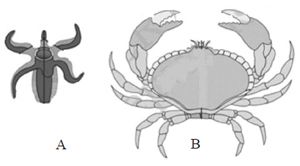
A. A : Biradial, organisms is divided into unequal halves by any plane through the central axis.
B. B: Bilateral, body is divided into equivalent right and left halves by only one plane.
C. A: Asymmetrical, organisms is not divided into equal halves by any plane through the central axis.
D. B: Radial, in which any plane passing through the central axis of the body divides the organism into two identical halves.
Answer : B

A. A : Biradial, organisms is divided into unequal halves by any plane through the central axis.
B. B: Bilateral, body is divided into equivalent right and left halves by only one plane.
C. A: Asymmetrical, organisms is not divided into equal halves by any plane through the central axis.
D. B: Radial, in which any plane passing through the central axis of the body divides the organism into two identical halves.
Answer : B
34. In amphibians, respiration occurs through
A. gills
B. lungs
C. skin
D. all of these
Answer : D
A. gills
B. lungs
C. skin
D. all of these
Answer : D
35. The given figures (A & B) shows the germinal layer. The animals having structures shown in the figures are respectively called

A. diploblastic, triploblastic
B. triploblastic, diploblastic
C. diploblastic, diploblastic
D. triploblastic, triploblastic
Answer : A

A. diploblastic, triploblastic
B. triploblastic, diploblastic
C. diploblastic, diploblastic
D. triploblastic, triploblastic
Answer : A
36. Polyp phase is absent in
A. Hydra
B. Aurelia
C. Physalia
D. Obelia
Answer : B
A. Hydra
B. Aurelia
C. Physalia
D. Obelia
Answer : B
37. Which of the following animal contains respiratory organs like, gills, book gills, book lungs or tracheal system?
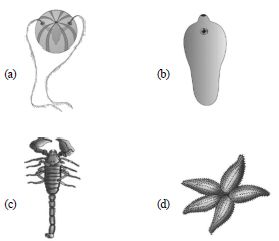
A. Click to check answer
B. Click to check answer
C. Click to check answer
D. Click to check answer
Answer : C

A. Click to check answer
B. Click to check answer
C. Click to check answer
D. Click to check answer
Answer : C
38. Which one of the following statement regarding coelom of given animals is correct?
A. Round worms (aschelminthes) are pseudocoelomates.
B. Molluscs are acoelomates.
C. Insects are pseudocoelomates.
D. Flatworms (platyhelminthes) are coelomates.
Answer : A
A. Round worms (aschelminthes) are pseudocoelomates.
B. Molluscs are acoelomates.
C. Insects are pseudocoelomates.
D. Flatworms (platyhelminthes) are coelomates.
Answer : A
39. Which of the following character is absent in all chordates?
A. Diaphragm
B. Coelom
C. Pharyngeal gill clefts
D. Dorsal nerve cord
Answer : A
A. Diaphragm
B. Coelom
C. Pharyngeal gill clefts
D. Dorsal nerve cord
Answer : A
40. The given figure shows some characteristic features marked as chordates. Identify the correct labelling A,B,C and D.
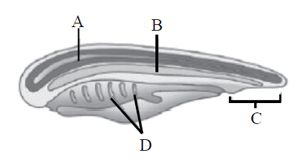
A. A-Notochord; B-Post-anal part; C-Gill slits; D-Nerve cord
B. A-Nerve cord; B-Notochord; C-Post-anal part; D-Gill slits
C. A-Notochord; B-Nerve cord; C-Gill slits; D-Post-anal part
D. A-Gill slits; B-Post-anal part; C-Nerve cord; D-Notochord
Answer : B

A. A-Notochord; B-Post-anal part; C-Gill slits; D-Nerve cord
B. A-Nerve cord; B-Notochord; C-Post-anal part; D-Gill slits
C. A-Notochord; B-Nerve cord; C-Gill slits; D-Post-anal part
D. A-Gill slits; B-Post-anal part; C-Nerve cord; D-Notochord
Answer : B
41. A file like rasping organ for feeding, called radula, present in the phylum __________.
A. arthropoda
B. mollusca
C. echinodermata
D. chordata
Answer : B
A. arthropoda
B. mollusca
C. echinodermata
D. chordata
Answer : B
42. Which of the following phylum is being described by the given statements?
(i) These are primitive multicellular animals and have cellular level of organization.
(ii) Digestion is intracellular.
(iii) They have a water transport or canal system.
(iv) They reproduce asexually by fragmentation and sexually by formation of gametes.
A. Porifera
B. Ctenophora
C. Coelenterata
D. Platyhelminthes
Answer : A
(i) These are primitive multicellular animals and have cellular level of organization.
(ii) Digestion is intracellular.
(iii) They have a water transport or canal system.
(iv) They reproduce asexually by fragmentation and sexually by formation of gametes.
A. Porifera
B. Ctenophora
C. Coelenterata
D. Platyhelminthes
Answer : A
43. Identify the correct characteristics of porifera.
A. (ii), (v) only
B. (i), (ii), (vi) only
C. (i), (ii), (iii), (iv) only
D. All of these.
Answer : A
- Commonly known as sea walnuts.
- Presence of ostia and collar cells.
- Exhibit tissue level of characteristics.
- It is the largest phylum of animal kingdom.
- The body is supported by spicules and sponging fibers.
- Contains cnidocytes which is used for defense, anchorage and capturing of prey.
A. (ii), (v) only
B. (i), (ii), (vi) only
C. (i), (ii), (iii), (iv) only
D. All of these.
Answer : A
44. The given figures A, B, C and D are the examples of first true land vertebrates. They are dominant in mesozoic era and belong to phylum ‘X’. Identify ‘X’ and the animals which have four chambered heart.
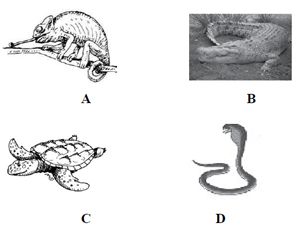
A. X – Reptile; B
B. X – Reptile; A
C. X – Amphibia, C
D. X – Pisces; D
Answer : A

A. X – Reptile; B
B. X – Reptile; A
C. X – Amphibia, C
D. X – Pisces; D
Answer : A
45. Tracheae of cockroach and mammal are similar in having
A. paired nature.
B. non-collapsible walls.
C. ciliated inner lining.
D. origin from head.
Answer : B
A. paired nature.
B. non-collapsible walls.
C. ciliated inner lining.
D. origin from head.
Answer : B
46. Which of the following group of animals reproduces only by sexual means?
A. Ctenophora
B. Cnidaria
C. Porifera
D. Protozoa
Answer : A
A. Ctenophora
B. Cnidaria
C. Porifera
D. Protozoa
Answer : A
47. Which of the following statements (i – v) are incorrect ?
A. (i) only
B. (iii) only
C. (i) and (iii)
D. (iii) and (iv)
Answer : A
- Circulatory system in arthropods is of closed type.
- Parapodia in annelids helps in swimming.
- Phylum mollusca is the second largest animal phylum.
- Aschelminthes are dioecious.
A. (i) only
B. (iii) only
C. (i) and (iii)
D. (iii) and (iv)
Answer : A
48. Which of the following pairs of animals are similar to each other pertaining to the feature stated against them?
A. Pteropus and Ornithorhyncus - Viviparity
B. Garden lizard and crocodile - Three chambered heart
C. Ascaris and Ancylostoma - Metameric segmentation
D. Sea horse and flying fish - Cold blooded (poikilothermal)
Answer : D
A. Pteropus and Ornithorhyncus - Viviparity
B. Garden lizard and crocodile - Three chambered heart
C. Ascaris and Ancylostoma - Metameric segmentation
D. Sea horse and flying fish - Cold blooded (poikilothermal)
Answer : D
49. The figure given below shows the germinal layers marked as A, B, C and D. Identify the label showing undifferentiated layer and its location?
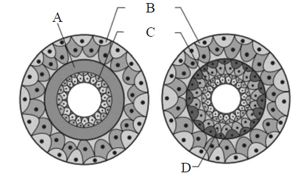
A. A, Between B & C
B. B, Between A & C
C. C, Between C & D
D. D, Between A & B
Answer : A

A. A, Between B & C
B. B, Between A & C
C. C, Between C & D
D. D, Between A & B
Answer : A
50. In phylum arthropoda, excretion takes place through
A. nephridia
B. flame cells
C. malphigian tubules
D. gills
Answer : C
A. nephridia
B. flame cells
C. malphigian tubules
D. gills
Answer : C
Sharing is caring
Related Post
Visual Basic .NET 1000+ MCQ with answer for RRB Group D
1000+ Heat & Mass Transfer Multiple Choice Question Answer [Solved]
1000+ Basics of Neurology MCQ for GMAT [Solved]
Current Affairs October 2022 MCQ Solved Paper for CEED
General Chemistry 1000+ MCQ with answer for RRB ALP
Phylum - Platyhelminthes MCQ Solved Paper for SSC JHT